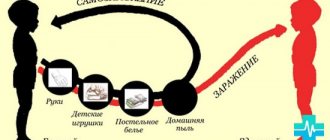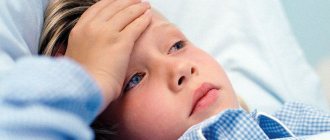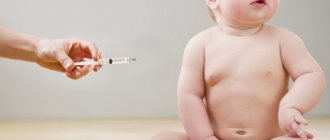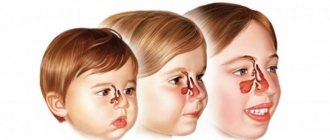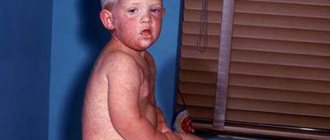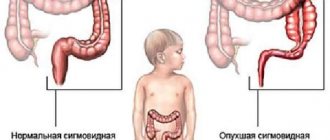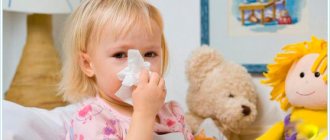Relevance of the problem
Moderate depressive symptoms can be observed in more than 20% of parents in Finland. The most severe symptoms occur in less than 9% of mothers and about 2.5% of fathers.
“Depression among parents, both during and after pregnancy, not only affects the person suffering from depression, but also has a long-term impact on the well-being of the newborn child. Even in cases of mild depression, it is important that symptoms are identified and parents are offered support as early as possible, if necessary, already during pregnancy."
, explains study author Johanna Pietikäinen.
Just 15-20 years ago, some child psychiatrists denied the possibility of depression in childhood, considering it solely a reaction of a maturing or mature personality (7, 8, 13, 15). In recent years, many works have appeared, based, however, mostly on single observations, describing depressive states in primary school, preschool and even infancy (9). But even if doubts about the existence of depression in children have disappeared, disagreements in views on their phenomenology, nosological affiliation, prognostic and differential diagnostic criteria have become even more acute. The prevalence of depressive syndrome in childhood remains completely unclear, which is explained, first of all, by the uniqueness of the clinical picture, “maskedness”, “atypia of symptoms, in comparison with depression in adults and adolescents. Hidden behind the facade of children's whims, behavioral disorders, academic failure and “school phobias,” childhood depression does not always come to the attention of a psychiatrist and is often diagnosed only retrospectively. Apparently, W. Spiel (17) is right in believing that depression in childhood occurs much more often than it is diagnosed, but it manifests itself in “other psychopathological images” and, projected onto one or another phase of the child’s development, takes on various “guises” " In early childhood, depression has a psychosomatic expression, manifesting itself in digestion and sleep disorders, breakdown of contacts, and developmental delays. In preschool age, depression is more characterized by attacks of fear, lability of affect and motor disorders, and in primary school age - by periodic decline in performance, dysphoria and a feeling of joylessness of existence.
Even with early recognition of childhood depression, the question of its nosology often cannot be resolved unambiguously. Van Krevelen (11) believes that the germs of endogenous psychosis often remain unrecognized in children, and serious life trials are needed for this predisposition to reveal itself. The occurrence of a depressive state in a child in connection with a conflict situation, according to the author, does not contradict its endogenous nature. If in an adult depression is filled with remorse, then in a child the content of depression relates to what “types a child’s existence, that is, the attitude towards parents.” In depression, a child discovers a feeling of abandonment; what the adult attributes to his own guilt, the child shifts to others.
Noting significant difficulties in distinguishing endogenous depression from reactive ones, V. and R. Kuhn (12) emphasize that the child is characterized not so much by self-blame as by dissatisfaction with the whole world, the behavior of parents, friends, and teachers. They also recognize the influence of a psychogenic factor on the occurrence or increased intensity of endogenous depression and at the same time rightly note that “healthy children are more resilient than we tend to assume; therefore, unfavorable environmental conditions especially affect unhealthy children.”
W. Spiel (16, 17) also believes that when a child is depressed, the boundary between vital melancholy and reactive concern remains unclear, since childhood is the phase of human development where patterns of behavior are developed and where the internal is controlled by the external.
As a result of statistical analysis, N. Remschmidt et al. (14) identified symptoms characteristic of endogenous depression in a child: anxiety, fear of death, obsessive states, overvalued overestimation of problems, phobias, hypochondriacal fears, fear of school and “vitality disorders” (sleep disturbances, headaches, feeling of pressure in the chest, heaviness in the body, loss of appetite, sweating, etc.).
According to most authors (2, 3, 12, 14, 16), the diagnosis of endogenous depression in childhood should be made with great caution; with short periods of observation, it is often unfounded and unconvincing and is confirmed only by the further course of the disease. Meanwhile, the role of correct diagnosis of depression in the early stages of its manifestation is undeniable. The need for early treatment and timely prevention of these conditions makes the development of criteria for diagnosing depression in a child an extremely urgent problem.
This work is devoted to clarifying the phenomenological features of endogenous depression in children and identifying its typological variants.
We observed 65 patients (37 girls and 28 boys), whose manifest depression arose before the age of 10 years. In total, the BUT of depressive states suffered by patients in infancy, preschool and primary school age was analyzed. In 8 patients, depression first appeared at the age of 1 to 2 years, in 20 - from 3 to 6 years, and in 37 - from 7 to 10 years. In 56 cases, the diagnosis of paroxysmal schizophrenia (recurrent or fur coat-like) was established, and in 9 patients with short follow-up periods, the diagnosis required differentiation between cyclothymia and low-progressive paroxysmal schizophrenia. In most cases (49 patients), observation was carried out in the hospital of the Moscow Children's Psychoneurological Hospital No. 6 and subsequently on an outpatient basis. 16 children were not hospitalized and were observed only on an outpatient basis. In our material, there are few depressive states of infancy: only two patients were observed by us during their stay in the Children's Home at the height of depression, for the remaining 6 patients the descriptions were compiled from the words of their parents and with the help of documentation from non-psychiatric medical institutions. Erased outpatient forms of childhood depression are also completely absent, which is explained by the conditions of patient selection - in an inpatient psychiatric hospital and at a consultation appointment at the Research Institute of Clinical Psychiatry of the All-Russian Scientific Center for Mental Health of the USSR Academy of Medical Sciences.
Depressive states in most children occurred with somatic complaints, so pronounced and massive that they sometimes determined the clinical picture, especially in the first weeks and months of the disease. Complaints about physical distress were noted in 47 (72%) children and were extremely varied (palpitations, dizziness, nausea, bulging eardrums, burning sensation and pain in the chest, headache, pain when urinating, pain in the abdomen, back, legs, arms , heart, etc.), essentially representing a somatoalgic syndrome. The most common complaints in preschool children were abdominal pain, and in primary school children - headache complaints. They, as a rule, were of the same type, described in few words, unambiguously and simply. Most often, conditions with massive somatovegetative and algic disorders were not constant, but were repeated in the form of defined attacks, accompanied by fear, motor restlessness and crying. In combination with lethargy, increased fatigue (“legs are tired, they don’t want to walk,” “arms, legs are heavy,” “it’s difficult to walk, I could barely drag my briefcase”), loss of appetite, significant loss of body weight, changes in the child’s appearance, they created a picture of a severe physical illness and at first were the subject of attention of pediatricians or surgeons. In two girls, 7 and 8 years old, the leading picture of the disease was lack of appetite with severe physical exhaustion; depressive disorders were not detected for many months, which was the reason for repeated examinations in somatic hospitals and subsequently for their treatment in children's psychiatric hospitals as patients with true anorexia nervosa. On the contrary, in 3 patients, against a background of depression, gluttony, indiscriminate eating, and excessive weight gain were noted. Cardinal signs for distinguishing somatized depression from a somatic illness can be changes in behavior, forms of response, a sharp and unexpected “change in character” of the child with passivity, indifference, isolation, tearfulness or, on the contrary, anger, aggressiveness, the presence of anxiety and especially fear, the absence of pathology with aspects of internal organs, as well as changes in well-being during the day, corresponding to the peculiar circadian pattern characteristic of endogenous depression in children.
The children never complained about being “sad.” They defined their mood differently, most often as “boredom”: “bored”, “sad”, “unbearable”, “want to cry”, “heavy heart”, “stone on the heart”, “dark wall”. Apparently, some of these sensations were equivalent to the affect of vital melancholy, although the correct verbal expression of the mood was almost always absent before the age of 10. Ideas of self-blame and self-deprecation were rarely revealed, were fragmentary, episodic and were expressed in naive statements: “I’m bad because I don’t like jelly and casserole”, “I don’t know how to ride a bike”, “I offend my mother”, “I torture my mother, and my father turned gray “,” “I’m the sickest, the worst, I’m ashamed with children,” “I’m dirty and I don’t know how to study.” More common, especially in children of primary school age with depression with impaired academic performance and fear of school, were sensitive ideas of attitude: patients believed that teachers did not like them for stupidity, peers despised them, did not want to be friends, sought to offend, laugh at their clumsiness, bad academic performance, inability to play, that they are uninteresting, unpleasant, even parents give preference to other children in the family. Cotard’s nihilistic delirium, described earlier in children (1, 4), in our observations was extremely rare - in 2 patients, unstable and rudimentary: “I don’t have a throat, but a bag with veins,” “all airways are closed,” “I don’t nose, but only the appearance of a nose.” Other delusional ideas (“alien parents,” fragmentary hypochondriacal delusions) that accompanied depressive syndrome in 5 patients were also unstable and fragmentary.
In 48 patients (66%), the predominant affect was anxiety and fear, which usually increased in the evening and at night. The affect of anxiety, like the affect of melancholy, in the child was difficult to verbally define. Vague, pointless anxiety, accompanied by general anxiety, was short-lived and quickly turned into concrete fear: being left alone, losing his mother, fear that his mother would not come to pick him up at kindergarten, that on the way from work she would get hit by a car or be killed by bandits. Along with fear, which manifested the transitivism characteristic of childhood, there was also fear for oneself, one’s health, life, and future (“I’ll grow up and suddenly become a bad person, a bandit, end up in prison”). Fear with severe motor restlessness and sleep disturbance was always accompanied by the paroxysmal states described above with somatoalgic disorders. Often fear acquired the character of enormity (“destruction of the world”, “end of the world”, “death of all people”, “atomic war”, “neutron war”). Fear of the future, future life and impending death (one's own and that of one's parents) also, as a rule, arose in the form of short-term episodes with tears, ideational excitement, and many questions about life, death, and the meaning of life.
In several cases, the fear of death was paradoxically combined with suicidal tendencies. Persistent suicidal statements were observed in 18 patients (28%). They were especially frequent at the time of raptoid states: screaming, sobbing, constantly moving, breaking free from the hands of their parents, children complained that they could no longer live like this, that living was “tired”, “boring”, “hard”, “unbearable”, “ I’m scared”, “I don’t want to”, they said that they would kill themselves, poison themselves, stab themselves, throw themselves out of a window, but more often they asked to kill them: “to give them a cure for life.” In preschool, some children tried to starve themselves to death; one boy tried to sit in a bath of cold water for a long time in order to catch a cold and die; For the same purpose, a 6-year-old girl breathed frosty air through the window, and then, hoping to suffocate, covered her head with a blanket. In total, suicide attempts occurred in 12 children. Most often they were of a “short circuit” nature, but in 5 patients they were not associated with provoking psychogenia, were thoughtful and were noted at the height of the depressive state.
Increased tearfulness and constant readiness to cry were present in depression in all children, and they were more pronounced the younger the child was. Increased sensitivity, pity were also noted (children cried over a broken flower, a cut down Christmas tree, a killed beetle), and a regressive animation of objects. The behavior of children often acquired a puerile connotation. They did not let go of their mother, they asked to be picked up and rocked; infantile intonations appeared in their speech, imitating the pronunciation of their younger brothers and sisters. Meanwhile, the mood of the same patients often had a dysphoric tint: the children looked not so much sad as gloomy and gloomy; they were irritable, angry, dissatisfied with themselves and those around them, grumpy, expressed a lot of claims and reproaches, and sometimes even became angry and aggressive. A shade of mood of the Unlust type was noted in 34 patients (52%), but it never appeared in isolation, but was combined with somatic complaints, anxiety, fear, suicidal tendencies, and depressive ideational disorders.
One of the most pressing topics discussed in the pediatric-psychiatric literature is the issue of maladaptation associated with depression in children of primary school age. Due to the severity of somatic complaints and ideation disorders in childhood depression, academic failure, refusal to attend school, and fear of school are often regarded as the result of a somatic illness, true oligophrenia, or are derived from a conflict situation. At the same time, according to many authors (5, 6, 11, 14, 17, 19), intellectual failure and so-called pseudo-retardance are not only extremely common, but also the earliest signs of childhood depression.
In the analyzed material, school maladjustment was noted in 57 patients (88%) with manifest or repeated depressive attacks. Ideational inhibition played a leading role in the decline in academic performance. As a rule, it arose gradually and gradually increased, manifesting itself in difficulties in comprehending and remembering educational material. Children spent more and more time preparing homework, did not understand what they read, recited the text many times at home, could not remember it at the blackboard the next day, could not solve simple problems, confused counting, and made mistakes in basic calculations. They began to complain that they did not understand the teacher's explanations, lessons were often taught throughout the day with the help and constant encouragement of their parents, or they stopped doing homework altogether. They cried a lot, wailing that all their efforts were in vain, that “there will still be a bad mark.” Indeed, at the blackboard they spoke slowly, had difficulty finding words, answered questions after a long pause or fell completely silent. They could not concentrate, became extremely absent-minded, forgot to prepare homework, forgot notebooks and textbooks at home, which also caused bad grades and comments. They complained about memory loss, stupidity: “my memory has deteriorated,” “I’ve become completely stupid,” “I don’t know how to study,” “I’m trying to understand and I don’t understand.” Particularly serious difficulties in learning arose with the addition of such thinking disorders as sperrungs, influxes of thoughts, a feeling of emptiness in the head (“the thought disappears”, “what I was thinking about, I don’t remember”, “thoughts creep into the head on their own”, “knock on the head - it empty"). Additional difficulties arose in connection with changes in the field of motor skills. Slowness and awkwardness previously unusual for a child appeared. Children took a long time to get dressed, often because of this they were late for school, could not run or play with their peers during breaks, and looked lethargic and clumsy during physical education lessons. The handwriting often changed, they wrote ugly, dirty, rewriting pages many times. In parallel with the awareness of their inadequacy, inability, the feeling of their alienness in the children's group and the development of sensitive ideas, the relationship became more and more pronounced; silence and isolation; the children became sad, boring, stayed away from the class, stopped taking part in public affairs, preferring loneliness, that is “depressive autism” was on the rise. The peculiarity of the circadian rhythm of affect with the lack of improvement in well-being and mood in the second half of the day completely deprived the child of the possibility of compensation.
Depressive states in children, and especially in younger schoolchildren, in most cases had a complex structure, representing a combination of endogenous and exogenous, true depressive symptoms, uniquely manifested and modified by age-related characteristics, and a personal defensive reaction that occurs in response to one’s own failure, the inability to - continue to assimilate and remain part of the children’s team and those social measures of influence with which, due to the lack of recognition of the painful condition, such children were approached. Such personal reactions include various neurosis-like disorders, including so-called “school phobias,” hysteriform states, conflict, and behavioral disorders. “School phobias”—fear of school, teachers, crowds of children, answers at the blackboard, tests—were often accompanied by stuttering, selective mutism, withdrawal, running away, and complete refusal to attend school. With dysphoric mood, especially in the presence of Unlust, a component characteristic of depression of primary school age, the psychopathic “mask” of depression was most pronounced.
Enuresis and encopresis, described as symptoms of childhood depression (10), were observed, as a rule, against the background of prolonged erased depressive states in preschool children (enuresis - in 33%, encopresis - less often - in 7% of cases). Other neurosis-like disorders (tics, stuttering, phobias), which often arose long before the onset of depressive symptoms, significantly intensified at the height of the condition.
Vegetosomatic crises, fear, equivalents of melancholy, hysterical reactions were always short-term (from 10-15 minutes to 1.5 hours), accompanied by motor restlessness and so-called “excessive crying” with an uncontrollable flow of tears. Dysphoria was usually just as unstable, appearing in response to a negative situation in the form of similar paroxysmal states lasting from 1 to 3 hours. The described paroxysmal states of various colors, raptus and actuation states occurred very often - in 48 patients (74%).
The described symptoms were very rarely stable and formed the picture of a solid, monomorphic, syndromic completed depressive attack. The vast majority of patients were characterized by diversity and variability of symptoms, saturation with a variety of disorders, fragmentary and syndromic incomplete, in combination presenting a complex and mosaic clinical picture. This circumstance largely made it difficult to determine the typological affiliation of childhood depression. Nevertheless, depending on the prevailing symptoms, it was possible to identify the following variants of depressive syndrome in children: 1) somatized depression (23%); 2) Unlust - depression (20%); 3) depression with fear (19%); 4) anxiety-agitated depression (16%); 5) depressive “pseudo-retard” (12%); 6) sluggish dynamic depression (10%).
Moreover, these variants of depressive syndrome had a certain age preference. Sluggish depression predominated in young children (up to 3 years). On the contrary, somatized depression and depressive “pseudo-mortality” arose only in children of primary school age, mainly from 7 to 10 years old; the earliest age at which depression of this type manifested itself was 6 years. Anxiety-agitated depression, depression with fear and Unlust depression were observed over a wider age range - from infancy to school age. In case of repeated depressive states observed in 30 patients, with age there was a tendency towards their modification from tearful, flaccid depression in young children to depression with fear and dysphoria in older preschool age and depressive “pseudo-mortality” and somatized depression in younger schoolchildren.
The predominance of one or another affect (boredom, sadness, fear, anxiety, dysphoria) and its intensity during the day were inconsistent and depended on both external circumstances and the time of day. The state of motor skills was also changeable, with alternation of inactivity and sudden motor agitation. Depressions with constant lethargy, silence or mutism, impaired contact with others, and lack of motivation were rare and, as already indicated, were observed mainly in early childhood. In most cases, a continuous “pulsation” was noted in the mood, well-being and state of motor skills, which definitely depended both on the situation and on the specific circadian rhythm characteristic of childhood depression. Unlike adolescents and adults, the circadian rhythm of affect in depressed children was smoother, there was no improvement in well-being and mood in the afternoon, “recovery by 5 o’clock in the evening.” The “correct” daily rhythm of affect was extremely rare - in only 4 children. In most cases, in the first half of the day, lethargy, weakness, slowness, ideational inhibition, and a feeling of boredom were predominant; during the day, due to the general increased fatigue of the child - fatigue, drowsiness, headaches; By the evening, motor restlessness, tearfulness, irritability, and anger increased. Outlined short-term hysterically and dysphorically colored episodes, somatoalgic crises and raptoid states were usually observed in the afternoon. Late in the evening and at night, anxiety and fear became prevalent, accompanied by sleep disturbances, illusions, and pareidolia, closely associated with affect and reflecting the main content of affective experiences. In a subjective assessment of their condition, even preschool children clearly noted a deterioration in their health in the evening and were afraid of the onset of darkness and the approach of night. The performance of children of primary school age fell sharply in the afternoon, which is definitely associated both with the increase in anxiety and restlessness in the evening, and with the increased fatigue of the depressed child. Thus, throughout the day, in children with depressive states, affect and physical state, changing forms of manifestation, remained negative.
Variability and susceptibility to external influences affected not only the nature of affective and movement disorders during the day, but also the entire depression as a whole. Short phase, described as one of the characteristic features of childhood depression (18), was extremely rare in our observations: the duration of depression from 3 to 13 days was observed in only 3 patients, and from 2 weeks to 1 month in two. In 17 cases (26%) the duration of depressive states was 1-3 months, in 18 cases (27%) - from 4 to 6 months, in 5 (8%) - 7-11 months. and in 20 patients (31%) - more than one year. At the same time, the intensity of depressive symptoms was variable and was associated with the external situation and the physical condition of the child. The undulating nature of depression was noted in 54 (83%) children. Against the background of long-term dull depression, short (from several days to 1 month) episodes of depressive disorders of a psychotic level were usually observed, associated, especially in the early stages of the disease, with severe somatic illnesses or psychotrauma.
The role of exogeny as a provoking factor was also very high in the occurrence of manifest endogenous depression (57 patients - 87%). Moreover, the most common and significant psychogenic disorder for children of primary preschool age (up to 4 years old) was separation from the mother, from the family (placement in a hospital, sanatorium, 24-hour kindergarten, nursery, orphanage, etc.), and for older children 5 years - long-term dysfunctional family situation (scandals, cruelty of parents, death of parents). Much less often (in only 3 observations) depression occurred immediately after acute psychotrauma - fright, sudden death of the mother. It was possible to establish a coincidence of manifest depression with a psychotraumatic factor in 49 patients (75%). In some patients, the provoking factor was a combination of psycho-somatogenesis. In 8 observations (12%), the manifest depressive state was preceded by acute somatic hazards (toxic flu, severe tonsillitis, childhood infections, acute appendicitis). In only 8 patients, overt depression was not associated with a provoking factor. With repeated depressive states, dependence on exogeny decreased by more than half.
Summarizing the described features of childhood endogenous depression, it seems possible to draw the following conclusions. Childhood depression is characterized by the prevalence of ideation disorders and somatic complaints, the predominance of the affect of anxiety and fear, the lack of verbalization of the affect of melancholy, increased tearfulness, the rarity and naivety of ideas of self-blame and self-humiliation, the severity of the dysphoric background of mood, a tendency to paroxysmal episodes of fear, dysphoria, motor restlessness, somatoalgic crises, the uniqueness of the daily rhythm of affect, as well as the combination of affective symptoms themselves with a personal defensive reaction. The reactive nature of the onset of childhood depression does not contradict its endogenous nature. Symptoms of childhood depression are characterized by undulation, variability and polymorphism.
The phenomenology of childhood depression is significantly different compared to adult depression and pubertal depression. Depression in a child is always “masked.” But it is precisely “camouflage” that is the most characteristic feature of childhood depression and is typical for it. Therefore, the use of the term “atypicality,” which is very common in modern psychiatry, is hardly legitimate in relation to childhood depression.
LITERATURE
1. Bashina V. M., Pivovarova G. N. Clinical features of depressive disorders in paroxysmal schizophrenia in children. Zhuri, neuropathologist. and psychiatrist., 1972, issue. 10, p. 1535-1540.
2. Vrono M. Sh. Some features of depressive states in children with schizophrenia. In the book: Scientific and practical conference on child psychoneurology. M., 1973, p. 28-29.
3. Lapides M. I. Clinical and psychopathological features of depressive states in children and adolescents. In the book: Questions of child psychiatry. M., 1940, p. 39-76.
4. Semenovskaya E.I. On the issue of the periodic course of schizophrenia in early childhood. Journal neuropathol. and psychiatrist., 1972, No. 10, p. 1541—1546.
5. Agras S. The relationship of school phobia to childhood depression.—Amer. J. Psychiat. 1959, 116, 533-536.
6. Annell A. - L. Depressive states in childhood and adolescence. - In: Depressive states in childhood and adolescence. - Stockholm, 1972, 11-15.
7. Asperger H. - In: Opitz H., Schmid F. (Hrsg.). Handbuch der Kinder - heilkunde. — Berlin, 1969.
8. Korboz R. Gibt es Geisteskrankheiten im Kindesalter? — Schweiz. med. Wschr., 1958, 88, 703.
9. Eggers Ch. Depressive Syndrome in Kindesalter. Fortschr. Med., 1977, 95, 16, 1082-1088.
10. Frommer E. Depressive illness in childhood.— In: Coppen A. a. Walk U. (Ed.). Recent Development in affective disorders., 1969, 117-136.
11. Krevelen Van, Arn D. Zyklothymien im Kindesalter.— J. Acta Paedopsychiatrica, 1972, 38, 7/8, 202-210.
12. Kuhn V., Kuhn R. Drug therapy for depression in children. Indications and methods. - In: Depressive states in childhood and adolescence. - Stockholm, 1972, 455-459.
13. Mah1er MS Sadness and grief in infancy and childhood.— The Psychoanalytic study of the child, 1961, 16, 332-351.
14. Remschmidt H., Brechter V., Mewe F. Zum Krankheitsver-lauf und zur Personlichkeitsstruktur von Kindern und Jugendlichen mit en-dogen-phobischen Psychosen und reaktive Depressionen.— Acta Paedopsychiatrica, 1973, 40, 1, 2-16.
15. Schulder. - Cit, Stu11e H. Psychosen des Kindesalters. - In: Handbuch der Kinderheilkunde. Bd. 8/1, Berlin, 1969, 908-937.
16. Spiel W. Depressive Zustandbilder im Kindes-und Jugendalter.—In: Melancholie in Forschung. Klinik und Bechandlung.—Stuttgart, 1969.
17. Spie1 W. Studien uber den Verlauf und Erscheinungsf ormen der kind-lichen und juvenillen manisch-depressiven Psychosen.—In: Depressive states in childhood and adolescence.—Stockholm, 1972, 517-524.
18. Stutte H. Epochale Wandlungen in Diagnostik und Verlauf endogen-depress ver Psychosen des Kindesalters—In: Depressive states in childhood and adolescence.—Stokholm, 1972, 29–34.
19. Torre M., Rovera GG Aspects de 1insuffisance scolaire dans les etats depressifs de la preadolescence.—Amer. J. Orthopsychiat, 1969, 36, 346-351.
SUMMARY
We studied 110 depressive attacks in 65 children of preschool and primary school age, patients with paroxysmal schizophrenia and cyclothymia. The conclusions are drawn that the main features of childhood depression are their “masked” nature with the prevalence of ideation disorders and somatic complaints, the predominance of the affect of anxiety and fear, increased tearfulness, the rarity and naivety of ideas of self-blame, a tendency to paroxysmal episodes of fear, dysphoria, motor anxiety, somatoalgic crises, variability of depressive symptoms and its susceptibility to the influence of the external environment, the uniqueness of the circadian rhythm of affect, as well as the reactive nature of the occurrence of depressive disorders. 6 variants of childhood depression have been identified.
Scientific research results
“In families, depression experienced by the mother has a key impact on the well-being of the child. In Finland, the maternity hospital system functions well, but attention needs to be paid to maternal depressive symptoms over a longer period, from pregnancy to the end of the child's first year."
, adds Pietikäinen.
The results of the study revealed several factors that lead to depression in mothers:
There are no friends nearby
Children don't know how to pretend. They will not fake a smile and pretend that everything is fine, at least when communicating with each other. When a child is sad all the time, other children will start to avoid him. They want to play, be naughty, have fun, and not find out what happened to their friend.
If your child communicated a lot, he had many friends, but they disappeared somewhere, then something serious happened. Try to get him to have a frank conversation; if that doesn’t work, consult a psychologist.
One parent's depression also puts the other at risk
Depression in one parent is a factor that may put the other parent at risk for depression. In addition, depressive symptoms in mothers and fathers are quite long-lasting: they can begin as early as pregnancy and continue after the child's first birthday.
“It is important to monitor the mental health of both parents during pregnancy and after the birth of the child, and if one parent is showing symptoms of depression, then the symptoms of the other parent should also be examined. However, at present, for example, psychological well-being is not necessarily covered by depression questionnaires in maternity hospitals.”
, notes Pietikäinen.
Constant fatigue
If your child often complains about being tired, don't ignore his words. First, you can visit a doctor and get tested. If there are no visible health problems, he may be depressed.
Observe your child's sleep. If he is sleeping more but does not feel rested, the reason is poor quality sleep. Your child is worried about something, he cannot sleep normally, and his body does not regain strength.
Never ignore your child's complaints. Many parents begin to shame their son or daughter, reproaching them: “We used to help our parents, we went to clubs, there was no time to do nonsense.” Such phrases will push the child away from you, he will close himself and will not talk about his well-being.
Previous depression is the most significant risk factor
Long-term depression is a sign that depression may have started before pregnancy. Previous experience of depression was in fact one of the key risk factors for moderate to severe depressive symptoms.
Other significant risk factors included sleep deprivation during pregnancy, stress, anxiety and poor family environment. These most important risk factors were predictors of depression among mothers and fathers.
The authors of another study determined whether maternal depression can cause ADHD in a child.
Change in appetite
Not every child has a good appetite; some children are very difficult to feed. You should be wary if your child begins to refuse food. Even his favorite treats do not please him, and he looks depressed.
Lack of appetite does not always indicate depression. Some people, on the contrary, “seize” the problem. If your child starts eating a lot and has a strong craving for sweets, start worrying.
Again, health problems should be ruled out first. You should not immediately register your child with a psychologist if his eating habits have changed; there should be other signs of depression.
Signs and symptoms of depression in children
Young children may complain of physical symptoms such as abdominal pain, but they do not complain of emotional pain. They may fear being separated from their parents, develop behavioral problems, or appear agitated and restless.
Symptoms of childhood depression include
- loss of interest in activities that the child was once interested in
- low motivation
- changes in sleep habits: baby sleeps too little or too much
- change in eating habits: overeating or undereating
- the child thinks or talks about suicide
- shows interest in death
- feeling of hopelessness
- low self-esteem
- problems concentrating
- new or escalating problems at school, with siblings or friends
- alcohol or drug use, especially among teenagers

